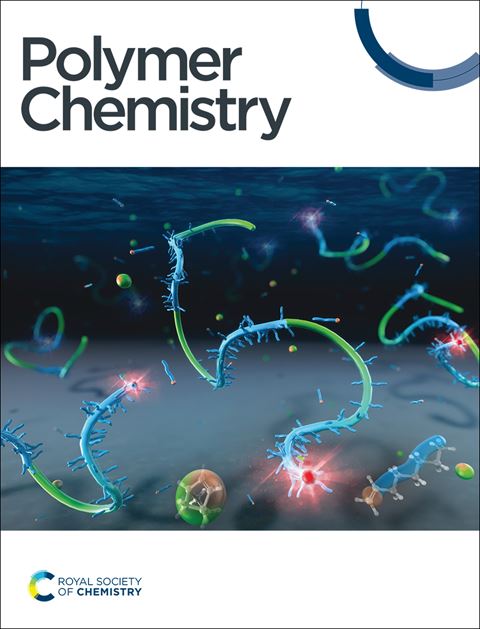Lewis acid ionic liquid catalysed synthesis of bioderived surfactants from β-pinene†
IF 3.9
2区 化学
Q2 POLYMER SCIENCE
引用次数: 0
Abstract
Cationic polymerisation of β-pinene (βP) via earth abundant catalysis has been investigated as a route to low molar mass poly(β-pinene) (PBP) for surfactant applications. As a ‘greener’ alternative to the often hazardous and poorly abundant Lewis acid catalysts reported for the cationic polymerisation of βP, imidazolium-based Lewis acid ionic liquids have been used as catalysts for the polymerisation, yielding polymers of up to Mn = 2560 g mol−1. Iron(iii) chloride (FeCl3) proved to be an effective catalyst for the transformation in a scaled-up, industrially applicable polymerisation resulting in polymers of slightly higher molar mass (Mn = 5680 g mol−1). Supercritical carbon dioxide (scCO2) proved to be an effective solvent for the purification of the polymers on a large scale, efficiently removing unreacted monomer and solvent. The unsaturated nature of the polymer has been exploited via post-polymerisation functionalisation reactions (epoxidation/hydrolysis and radical thiol–ene), endowing the polymers with hydrophilic groups. The functionalised PBPs were fully characterised, demonstrating variations in thermal properties compared to the unfunctionalised polymer. Finally, with careful balancing of the amphiphilicity, the functionalised polymers were shown to stabilise oil/water emulsions for up to two weeks, demonstrating the potential of these bioderived materials in several surfactant applications.

路易斯酸离子液体催化合成β-蒎烯生物表面活性剂
通过富土催化法对 β-蒎烯 (βP)进行阳离子聚合的研究,是一种用于表面活性剂的低摩尔质量聚 β-蒎烯 (PBP) 的途径。据报道,在 βP 的阳离子聚合过程中,路易斯酸催化剂通常具有危险性,且含量较低,而咪唑基路易斯酸离子液体则是一种 "绿色 "催化剂,可产生 Mn = 2560 g mol-1 的聚合物。事实证明,氯化铁(III)(FeCl3)是一种有效的催化剂,可在工业应用的聚合反应中进行放大转化,从而产生摩尔质量稍高(Mn = 5680 g mol-1)的聚合物。事实证明,超临界二氧化碳(scCO2)是大规模纯化聚合物的有效溶剂,可有效去除未反应的单体和溶剂。聚合物的不饱和性质可通过聚合后功能化反应(环氧化/水解和自由基硫醇-烯)加以利用,从而赋予聚合物亲水性基团。对官能化的 PBPs 进行了全面的表征,与未官能化的聚合物相比,它们的热性能发生了变化。最后,在仔细平衡了两亲性之后,功能化聚合物可以稳定油/水乳液长达两周,这表明了这些生物衍生材料在多种表面活性剂应用中的潜力。
本文章由计算机程序翻译,如有差异,请以英文原文为准。
求助全文
约1分钟内获得全文
求助全文
来源期刊

Polymer Chemistry
POLYMER SCIENCE-
CiteScore
8.60
自引率
8.70%
发文量
535
审稿时长
1.7 months
期刊介绍:
Polymer Chemistry welcomes submissions in all areas of polymer science that have a strong focus on macromolecular chemistry. Manuscripts may cover a broad range of fields, yet no direct application focus is required.
 求助内容:
求助内容: 应助结果提醒方式:
应助结果提醒方式:


